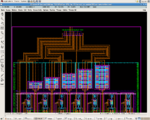viperpaki007
Full Member level 5
Hi I am making a clock distribution circuit working at 4GHz. Generated clock is needed by flipflops. I tried to route the clock in such way that the distance of clock source to all flipflops remain same. Moreover, i put a ground line between clock signals to reduce interference. However, as soon as i do the extracted simulations with interconnect parasitics, i observe the following warning msg from spectre and the simulations do not proceed further.
Vgs has exceeded the oxide breakdown voltage of `vbox'=2.6V
My supply voltage is 1.2V and the circuit works properly without the parasitic extraction. Therefore, i assume that there is some problem with layout design which is causing some interference glitch to appear at the transistors and increase the voltage beyond the gate oxide breakdown voltage. I am attaching the screenshots of my layout. Can somebody suggest what should i do to avoid this problem.
I have already tried to add a capacitor between vdd and vss lines but it does not solve the problem
Vgs has exceeded the oxide breakdown voltage of `vbox'=2.6V
My supply voltage is 1.2V and the circuit works properly without the parasitic extraction. Therefore, i assume that there is some problem with layout design which is causing some interference glitch to appear at the transistors and increase the voltage beyond the gate oxide breakdown voltage. I am attaching the screenshots of my layout. Can somebody suggest what should i do to avoid this problem.
I have already tried to add a capacitor between vdd and vss lines but it does not solve the problem
